Enhancing Youth Self-Regulation Through Wearable Apps Increasing Usage Through Participatory Design in Low Income Youth
ABSTRACT
Managing attention, progressing towards goals, and monitoring behaviors are elements of self-regulation (SR). SR applications based on contemplative practices such as breath counting have reached success, but have failed to engage youth. Prior research generated behavioral and neurological changes, but was disliked by youth. This two part study includes a participatory design workshop and field study to understand how wearable devices can support self-regulation. Twenty-seven youth designed activities that revealed interest in and models of self-regulation that became part of a smartwatch app. Redesigning the application to be responsive to youth needs resulted in higher levels of satisfaction than previously observed. Youth also used this application more often and reported higher use. Two design tensions persisted: (1) Breath counting applications as attention grabbing vs. attention cultivating and (2) breath counting activities as a relaxation activity vs. a mental workout. Activity occupied positions along these continua, which creates associated challenges.
CCS CONCEPTS KEYWORDS
Participatory Design; Theory of Self-Regulation; Tools for Development and Well-Being; User Designed Technology; Wearable Technologies
1 INTRODUCTION
Non-cognitive skills such as grit, tenacity, perseverance have recently captured the public imagination, as evidenced by Duckworth’s New York Times best-selling Grit: The Power of Passion and Perseverance [26]. Research on non-cognitive skills documents how non-cognitive skills predict success across a variety of domains including academic achievement [38].
Underlying such skills is the psychological construct of self-regulation, the enactment of skills to monitor and regulate one’s activities [32, 38]. Self-regulation is trainable and increasing self-regulation can improve performance across domains [32, 38, 93]. Scaling such interventions, which often begin with a group activity led by an expert and involve little follow-through or feedback in the context of practice, can be difficult [38]. In response, researchers are developing personalized technologies that collect, track and report on data to scale such interventions, which, if they leverage the capacities of such technologies, may also improve interventions [38, 51]. Consumer-facing products are also exploring this space, but are often geared toward adults and lack theoretical or research underpinning [73].
Game-based approaches are increasingly used for non-cognitive skill development, particularly given the success of “brain games” [39]. Established trainers such as CogMed have integrated game-based metaphors, interfaces and interactions [56]. Researchers have also demonstrated game-based approaches to improving cognitive and non-cognitive scores using off-the- shelf software such as Super Monkey Ball, Mario Kart, and Big Brain Academy [56]. The efficacy of “brain games” (game- based approaches to improving cognition) is hotly debated [69]. However, if “brain games,” and even commercial games can improve cognitive skills, might they also be used to train non-cognitive skills?
In previous work, researchers created a gamified breath-counting application for the iPad that combined training techniques demonstrated to improve self-regulation among meditators, with digital game-based learning techniques. This project (redacted) to improve self-regulation of attention led to an increase in youth self-regulatory behaviors compared to control groups, including changes in fMRI scans of the brain. Despite promising results, youth did not enjoy — and some even resisted the learning experience. Interacting with an iPad was cumbersome; pulling out an iPad monopolized activity and was often difficult during moments opportune for breath counting. Might wearable technologies offer new opportunities to explore breath counting as both a model and method for improving self-regulation?
In this two- phase study, we (1) lead participatory design workshops for youth in which we discussed self-regulation and assisted them in designing technologies to improve them, and (2) redesigned a mobile technology for self-regulation based on these findings and studied how youth used the redesigned application. Youth had existing notions of self-regulation primarily based around completing academic work, augmented by listening to music. The self-regulation of attention was highly relevant to these students who were interested in developing and managing their attention. Students’ initial designs focused on standalone applications and traditional games (particularly rhythm music action games), but after reviewing these tools that they designed, they opted for wearable devices. They wanted tools to assist them in managing stress and improving their homework performance. Their designs leveraged biomarkers and immersion into interactive music experiences, but few social features.
Based on these findings, researchers redesigned Tenacity for the Apple iWatch, which integrated breath counting mechanics similar to the iPad application, but also added two new modes based on youth interests and preferences: Infinite, an infinite breathing mode for relaxation, Lotus Swipe, an attention focusing mini-game. Early in the study, we also developed a prototype of a music rhythm action game, but abandoned it due to latency and response issues. We also changed the usage requirements and this time, asked youth to try and use the application every day, but to do so as was useful. We observed on average, youth using Tenacity 8 minutes per day. Breathe Infinite was the most used application (6.75 minutes per day). Application usage was distributed relatively evenly throughout the day, with notable spikes after school and at night (before bed). In post interviews, youth identified a persistent design tension between approaching the application as a game, which they expected to grasp and hold their attention, vs as a training tool for them to develop attention. A second tension emerged between the application as a tool for relaxing (e.g. after school, before bed), and as a training tool, which recruits more focused effort. The pursuit of self-regulation of attention as its own activity separate from an outside interest, may be a relatively niche activity appealing to a subset of users. As researchers, we need to weigh the benefits of promoting emotional regulation as its own activity, compared to cultivating attention in the service of youth-initiated pursuits, which could include physical exercise, sport, or breath counting.
2 THEORY OF SELF-REGULATION
Self-regulation (SR) deals with both conscious and subconscious modification and control of cognitive, social and emotional states. SR processes are associated with the anterior cingulate cortex (ACC) in the prefrontal brain region, which overrides response tendencies and has been associated generally with self-control [9]. Self-regulatory behavior implicates a full suite of executive functions (EF) that includes working memory, set shifting, inhibition, and monitoring [2, 59, 63, 91]. A person relies on SR to attend to their self and environment, organize motivations to set goals, and establish repeated behaviors to pursue activities that meet desires, motivations, and demands [92].
On a conscious level, SR is (for example) recognizing an angry feeling and diffusing it through implementing a calming strategy. Conscious SR can, however, also be the development and maintenance of a study plan to optimize academic learning and achievement. Subconsciously, it underlies efficacy in tasks that involve working memory and multifaceted skills such as reading comprehension [47, 85]. Self-regulation is an encompassing construct that plays a deterministic role in our pursuits of academic and social development [6, 11, 21, 33, 71, 78]. A person with diminished SR will encounter difficulties in directing attention during instruction and times of study, managing problems at school and home, and making progress in personal activities with rising complexity.
2.1 Educational methods for improving self-regulation
SR is not a single trainable construct, but a collection of cognitive faculties that can each be trained to affect overall self- regulatory behavior. A number of studies have used targeted activities to train executive functions (EF) that improve scores on EF and SR tests [8, 46, 47, 50, 61, 77, 86]. However, isolating and training EF to promote overall SR is imperfect, as transfer of learning from single EF can be narrow onto untrained tasks [21, 73]. Reduced transfer means that isolated training risks low performance outside of the training context and limits general applicability.
Studies that show wider transfer of EF training onto untrained tasks involve extended activities situated in complex sociocultural environments [20, 21, 53, 66, 67, 68]. Oaten & Cheng examined the development of SR through genuine participant activities with a heavy focus on planning and reflection across school, fitness, and finance [66, 67, 68]. Common to all three contexts, participants kept detailed logs and journals about their goals, progress, challenges, and plans to achieve targeted outcomes. Targeted reflection questions that initiated reflection activated executive functions while also providing evidence to monitor and act upon in the future. Similarly, reviews of EF training programs that include computer training, physical activity, Montessori school, meditation, martial arts, and mindfulness practice find that successful EF programs introduce EF explicitly, address EF across activities, occur over extended periods of time, occurred throughout the day, provide progression through increasing challenges, and in some cases, include scaffolding and mentorship [21, 53].
Successful efforts to promote EF share common features including goal-directed behavior, effortful cognition, and self- reflection on one’s attention. Such activity diversity suggests that the participant’s disposition and orientation toward the activity may be more relevant to the development of executive functions than the genre of the activity itself [84].
2.2 Game-based models of self-regulation
Game-based training tools have emerged as a model for managing attention and self-regulation [69]. Tools such as Luminosity and Elevate show gains across cognitive tasks [39; 65]. Although none are targeted explicitly at self-regulation, studies of video game players have shown increases in visual attention systems [1]. Yet, cognitive training tools have been critiqued for employing game mechanics that are little more than reworked versions of cognitive tests themselves, making the intervention “test taking” training rather than training underlying cognitive systems [57.]
Despite their impact in the research literature, research on brain-based training games and commercial games are still relatively separate. Established trainers such as CogMed increasingly employ game-based metaphors [45, 50]. SR training programs based on from regular commercial games (such as Super Monkey Ball, Mario Kart, and Brain Age) have demonstrated nearly 1⁄2 of a standard deviation improvements on IQ tests [56]. The fact that video games may train SR illustrates a dilemma: While society wrestles with increased diagnoses of youth as lacking sufficient attentional resources, some of the very activities blamed for these deficits may also be training them. This contradiction reminds us that self-regulation is not simply a matter of “building muscle,” but also building the desire and ability to deploy it (in this case in the manner and toward the activities also valued by adults). Could games be developed that train SR in specific contexts while also including features that encourage youth to deploy them toward other contexts as well?
Breath counting games based on mindfulness training have been demonstrated to improve attentional self-regulation [8, 17, 52]. The Breath counting core mechanic is relatively removed from assessment tasks compared to traditional “brain games.” In a study of youth using Tenacity, a breath counting app (figure 1) over a two-week period, researchers found improved attentional self-regulation as measured by both behavioral tasks and neurological imaging [8, 17, 52, 55]. Evidence for physical brain changes over only two weeks of use is inspiring, and suggests Tenacity may be an example of a high leverage psycho- sociological intervention that produces dramatic impact over short exposure time through the careful matching of intervention design to target population needs [89].
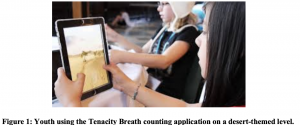
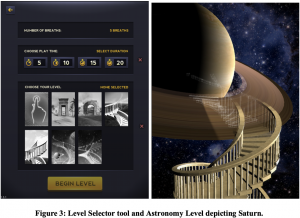
Although studies of breath counting games demonstrate their efficaciousness, they also reveal challenges in promoting their use among youth. Researchers reported issues with youth voluntarily adopting the self-regulation tool and youth reported not enjoying the experience. Adapting the application to better reflect their interests and desires and situating the game within a more robust social context could increase its appeal while also promoting the social/metacognitive practices associated with transfer in other settings [73]. Features and practices from personalized tracking on wearable devices is one such avenue promising for increasing engagement.
2.3 Personalized Tracking for self-regulation
Personalized tracking on mobile platforms and technologies have potential to improve the regulation of attention [59, 62]. Through personalized trackers, users can collect, visualize, and share data [49]. Personalized trackers can detect behavioral markers, detect opportune moments for intervention, select context-sensitive interventions, collect data on activity, and adjust intervention patterns in situ [35, 42]. Even relatively simple mood mapping apps that poll users’ moods without employing biomarkers can improve mood through encouraging users to reflect on the conditions that led to their mood changes [10]. Simply recording and reflecting on feelings of well-being on mobile devices can improve well-being. [48]. However, use of personalized trackers can be sporadic and may be improved by designing for different levels of readiness, encouraging playful goal setting, and designing for sustained engagement.
In situ studies of users with physical trackers reveal the complexities in designing for behavioral change [35]. Across multiple studies, the most common practice among users of physical trackers is glancing, which are brief 5 second interactions in which users check progress according to goals [35a]. Users rarely look back on past data, and in one study, only 30% of users set daily step goals, and of those who did, 80% never updated their goals [42]. Gouveia and colleagues conclude that “current physical activity trackers work only for people in intermediary stages of behavior change (i.e., contemplation, preparation).” Those in other stages (precontemplation, action, or maintenance) use them less. Trackers were most often used while glancing at the time, checking in during an activity, planning future activity, and alleviating boredom. Researchers advise that designers support “micro-plans,” (users’ immediate activity plans) which illuminates the context-sensitive nature of tracking. What works for one type of physical tracking (e.g. walking) at one point in a person’s life may not apply to another activity at another time. Trackers benefit by being designed for specific populations doing specific tasks within a specific point of their trajectory within the activity.
Personalized Tracking devices can employ health intervention techniques to influence behavior [35; 62]. Behavioral change techniques can be embedded in messaging systems by including messages such as “identify barriers” or “prompt a review of behavioral goals” [35]. In exercise apps, such techniques are associated with increases in the target behavior [62]. A taxonomy of 40 health intervention techniques is useful for persuasive technology developers, but meta-analysis of such interventions reveals that “more is not more,” and good design combines such features to create compelling experiences [39; 42]. Studies of what youth desire and how youth use such trackers can help researchers design better systems, particularly with disadvantaged or marginalized youth [87].
2.4 Participatory Design with Youth
Participatory design offers one model for studying the tacit understandings, mental models, and practices that youth participate in which may be built upon for designing self-regulation tools. Participatory design, the sustained engagement between designers and stakeholders seeks to create more usable products while also understanding the context of use, particularly the forms of tacit knowledge that participants bring to a task [79]. Politically, participatory seeks to elevate users’ voices as equal to designers so as to understand their values and support their practices, and empower them in achieving their goals [64]. Specifically, participatory design could help designers understand how youth regulate their attention and what features they desire.
Participatory design approaches are highly iterative, and feature designers and users participating as equals. Participatory design approaches may differ in enactment, but most follow a pattern of 1) Initial explorations (interviews, discussions, and observations), 2) discovery and envisioning (storyboarding, role playing, and 3) prototyping (prototyping, modeling, physical prototyping) [78]. Participatory design researchers emphasize improving the quality of life for participants as outcomes, not just reaching researchers’ or designers’ goals. Design participation is ultimately an evolving iterative process of making, telling, and enacting, with the most compelling evidence of success lying in the valued and sustained use of objects over time [7].
Participatory design with youth presents specific challenges and benefits [24, 25]. Researchers must support youth in expressing their concerns, through their voices, but also need to make up for potential gaps in skills, background, or context for the design activity [58]. As such, there is often an instructional component to participatory design with youth, so that design researchers help youth understand the underlying task. Once design researchers are positioned as experts, participatory design projects risk positioning the enterprise within the designers’ framing and steering youth toward designers’ solutions. Even within these constraints, researchers such as Druin have achieved success engaging in co-design with youth [24, 26, 27]. Small groups of youth with small numbers of researchers can avoid reproducing the culture school where a teacher directs activity. In studies conducted over a decade, researchers found that youth desired control, social experiences, and capacities for expression, and they, valued how cool, how easy-to-learn, and aesthetically pleasing tools were [24].
Subsequent work uses design workshops as a framework for teaching design thinking, which itself the core desired learning outcome [42]. Design thinking, is in short a process for considering human needs, proposing and iterating solutions, and evaluating their impact [15, 41]. Ideo’s framework, which is one of the most commonly used among educators, emphasizes three pillars of design thinking: Empathy, ideation, and experimentation, which together, constitute both core practices and desired learning outcomes. Design thinking researchers emphasize the importance of collaborative inquiry, the overlap between cognitive and social practices as being generative for learning in design workshops [45]. As youth communicate in design, as they understand, observe, articulate, ideate, prototype and test in groups, they reflect on and codify understandings [45].
This paper hypothesizes that participatory design workshops for youth might uncover better understandings of how youth conceptualize self-regulation including helping us reach better understandings of how they conceptualize self-regulation in practice, yield better self-regulation tools, and perhaps help improve youth understanding of self-regulation.
3 METHODOLOGY
This design-based research study seeks to understand youth use of a smartwatch application to promote self-regulation of attention. Consistent with design-based research methods, it seeks to build and refine theory while also building a tangible artifact that embodies those findings [3, 13, 19, 23]. It includes three phases: (1) a participatory design workshop in which youth redesigned an efficacious but unpopular breathing app for wearable devices, and (2) an enactment of the system that leverage features and practices youth engage in, and (3) a naturalistic study of how youth use these devices including observations, interviews, and surveys.
3.1 Research questions
- How do youth conceptualize their self-regulation into designs, explanations and artifacts?
- What self-regulation patterns do youth engage in and how might they be supported with wearable technologies?
- What features do youth desire in wearable self-regulation technologies?
- How do youth use wearable technologies for self-regulation, and how might they be supported through participantstructures?
3.2 Participatory Design Workshop
To investigate youth interests, ideas, and relationship to self-regulation, we conducted: (1) a participatory design workshop with low income youth, and (2) a pilot study in which participants used devices with a wearable Tenacity application installed for two weeks.
3.2.1 Participants.
Twenty-seven middle schoolers from a low socioeconomic status middle school volunteered to participate in seven day 90- minute after-school design workshops in which they designed technologies for self-regulation. Youth were from 6th through 8th grade; their ages ranged from 11 to 14 years old. Students were compensated through daily lunch and a $30 Amazon gift card on the final day. A classroom teacher was present for all sessions and shared observations.
3.2.2 Data and materials.
A participant-researcher led each session and was attended by 1-3 participant-observers. Participant observers took notes and made observations, as well as participating in activities. Consent was given by youth and parents in accordance with IRB procedures. Each session was recorded with two video cameras and one audio recorder per group, and researchers took notes. Design documents and artifacts were collected or photographed.
3.2.3 Procedure.
The workshops began with a presentation on self-regulation research and an example of self-regulation training, including an example of a previous iPad application [70]. Youth were then organized into groups that brainstormed and prototyped devices and apps to train self-regulation. As groups developed their ideas, they were given additional design challenges. Figure 3 depicts an early prototype of a biofeedback driven music service that would support attention focusing. Figure 4 shows another approach to music games for concentrating; it involved a piano controller prototyped through Makey Makey.
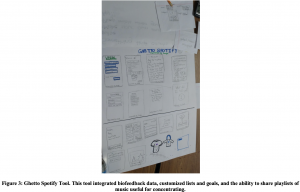

3.2.4 Youth Design Activities.
Design activities (see Table 1) built on previous participatory design workshops for Latinx youth [87]. Design activities were presented as challenges, such as “Make a game prototype,” “Merge multiple ideas together,” or “Storyboard an idea.” Challenges were created to direct youth activity in a non-didactic way. At the day’s end, groups reflected on progress, shared activities and thoughts, and identified ideas. After three workshop days, groups reorganized to start new projects, which was intended to diversify ideas. Figure 3 captures one such project with design artifacts and a storyboard. On the last day, groups convened to reflect on the process.
In the first round, youth designed four games: (1) A space exploration game that used mini-games to improve attention focusing, (2) A worker game in which players must keep their job while managing distractions, (3) A fidget device that integrated a clicker (similar to a spinner) with earbuds, and (4) A music tone matching app in which players match tones while in rhythm. In the second round, researchers narrowed the focus to be explicitly on wearable devices for self-regulation of attention. These ideas include: (1) A heart rate tracker that responds to youth stress and suggests activities, (2) Finger stress puppets that are connected to an application, (3) A white noise device that includes music and rhythm activities, and (4) a focus monitoring application including scheduling, achievements and competitions for staying on task.
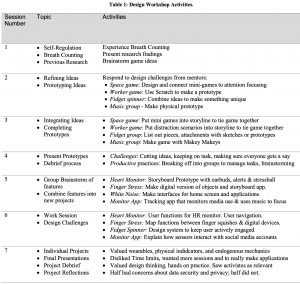
Researchers met after each session to identify themes and adapt workshop activities. Emerging themes were recorded in a shared data repository, with accompanying notes on groups or data sources to analyze more deeply. Following the workshop, researchers reviewed audio recordings and design artifacts and chose key events to examine in-depth and transcribe. We present our findings as warranted assertions to answer our research questions [80].
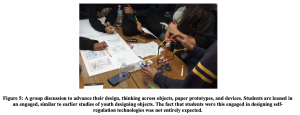
4 YOUTH DESIGNS, ARTIFACTS, AND EXPLANATIONS
The social atmosphere was informal and lively; youth (1) valued designing SR apps and (2) discussed strategies for managing stress and focus with sophistication. Youth reported enjoying exploring new friendships and experiencing others’ points of view in the design activities (although they did not enact social mechanics in their designs). The following themes reflect of activity across groups.
4.1 Youth conceptions of self-regulation
4.1.1 Youth employed sophisticated models of self-regulatory behaviors in design, largely as a result of employing self regulation while doing homework.
In early design phases, youth discussed strategies for focusing. Jasmine (all names are pseudonyms) shared that she used music to get into a “hard working” mood (which was common). Wyatt shared that stress motivated him to work hard and focus— a view similar to the Yerkes-Dodson law [90]. Wyatt reflects that stress helps him avoid consequences of not completing schoolwork or missing deadlines. Wyatt later connected stress to biological markers, and wanted more data on such markers: “if you’re stressing out and your heart is racing, then a metronome of your heart may help you realize you’re stressed and then you can calm down to refocus.” Most groups were interested in biological markers on devices to alert them on stress levels.
4.1.2 Youth employed a variety of techniques, but particularly music to augment their SR.
Music was commonly cited as a motivational tool, mood setter, and ally for channeling stress. Although music listening is not commonly discussed in SR literature, The Mozart Effect (which originated as a claim about improved performance while listening to Mozart’s composition) is understood to describe a music-induced neurological response within a network (including the anterior cingulate cortex previously implicated in SR) of mesolimbic structures involved in regulating and processing rewards and emotions [60, 82]. Other media influences mood; humorous media is associated with improved performance on self-regulatory tasks when SR energy is depleted [43]. It should be noted that music and mood-altering media do not train SR, but rather interact with the SR system to create a psychological and physiological response (i.e., they counteract depletion effects but do not broadly improve normal SR functioning [4)]. These findings suggest that in addition to training SR, researchers might also give youth tools to improve their SR. In fact, after observing youth reports of homework pressures, researchers became increasingly wary of adding additional regulation depleting tasks to their day.
Most youth were more interested in augmenting their performance than training their underlying SR. Youth such as Wyatt and Jasmine did not describe focusing attention in reference to self-regulation, but rather as motivation or energy and sought tools to augment behavior. In contrast. Self-regulation includes both inhibiting behaviors and the subsequent enactment of others from within oneself [6]. An external mediator present in a youth’s SR model might also indicate where youth have an underdeveloped understanding of what SR looks like, and how they can make improvements to their self-regulatory behavior.
4.2 Youth designing SR for devices
4.2.1 Proficiency in SR design activities.
Teams mobilized gaming experiences to develop designs for self-regulation apps and created designs quite similar to those designed by our design team in earlier phases. In fact, the design processes and products were remarkably similar to those of our team of professional game designers (with over 100 years of AAA commercial experience). Youth reviewed existing games, proposed ideas, created artifacts, and iterated plans while managing group cohesion through consensus building techniques (see figures 2, 3 & 6). Teams made storyboards and mock-up interfaces with very little instruction or prompting. They demonstrated tacit knowledge for constructing a user interface (UI) and fully discussed journeys through possible onboarding experiences (e.g., email, profile setup, user details). Roles, which included note-takers, illustrators, constructors, and voice leaders emerged organically. Note-takers kept bulleted lists and summarized directions discussed. Illustrators made diagrams and sketched prototypes. Constructors produced tangible artifacts from illustrations. Voice leaders gave team direction, and managed enthusiasm. Roles were flexible, with youth assuming different roles. Teams split so members could think independently, and convened to share their ideations. The quality of the youth design conversation impressed researchers, who themselves had decades of experience in the domain.
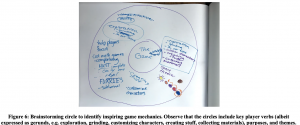

4.2.2 Game Play, Mechanics, and Transfer.
Youth wrestled with core design issues, including challenges such as the situated nature of self-regulation and transfer across contexts. Early in design, youth entertained grand ideas and then shed them for smaller, more achievable designs. One design placed the player in charge of running a pizza shop that placed an enormous strain of activity upon players. While running and operating the pizza shop, natural disasters, human conflict, and other chaotic events would challenge the player in staying on task and efficaciously managing the space. During a reflection at the end of a session, Apolonia provided feedback that was supported by many others, “This is meant to be a game, so it’s not disingenuous to the idea of a game. You can’t tell it’s a game made for something, it’s a game made for fun. I don’t have to play this ‘game’ to practice my focusing skills.”
Mario—the lead on the pizza shop design—shared his design philosophy,
“You can practice being in the situation where you have all these things happening but you are still doing the thing you need to do. Everyone likes to feel like they accomplished something. You can learn to handle distractions.”
Apolonia’s critique and Mario’s design philosophy can seem to conflict. Apolonia didn’t want to play a game to practice focusing skills. But Mario’s design has the player practice remaining focused in a distraction-laden environment. The important message here, is that Apolonia values skill training when it is accomplished in the service of the dominant activity—running a pizza shop—rather than being the sole focus of the activity. This design tension mirrored our own, that we wrestled with through the duration of this project.
Across designs, youth expressed interest in creating and fostering a community of players focused on SR rather than improving SR as a discreet skill. To use the martial arts metaphor, youth were more interested in creating dojos than in training specific moves. While fewer cognitive science studies discuss the social aspects of SR development, other socio- cultural studies of SR development attach a strong value to social practice in the development of both self- and other regulation.
4.2.3 Challenging games with simple mechanics.
The physical piano keyboard interface design created a game in which the keyboard interacted in rhythm with on-screen moving targets (e.g., Guitar Hero, osu!, Audiosurf). The game was intended to be minimalistic compared to commercial rhythm action games, however. Apolonia connected the game concept to a commercial hit in youth culture,
“[The piano game] is such a simple concept like Flappy Bird, and you’re overestimating your abilities, and when you fail you want to try again and again.”
Commercial games in this genre feature failure and provide many attempts to master complex and difficult gameplay. One advantage of such designs are their portability and accessibility. Games such as Flappy Bird and Music Line can be played on
short notice, while in transit, and at other transitional times. Play is designed to be extended over multiple longer play sessions and provide hours of designed progression.
4.2.4 Social interaction design.
A third design turned the quantified-self into a game. Players would team up and compete against other teams similar to FitBit “step count” challenges. The app monitored a player’s usage of other apps and activities and compare the amount of time spent versus other teams. So if team 1’s total time spent watching YouTube was lower than team 2’s, team 1 would receive points. Other competitions could include time spent studying or other player defined constructs (e.g., physical activity and eating sweets). Caspar supported the group’s designs by revealing his underlying values,
“The competition part makes you want to use it more, but there should be a beginning with a time limit that everyone needs to follow, and then it ends.”
Social interactions have narrow development for both commercial games and SR programs. A majority of the current interventions focus on learner-to-adult and learner-to-program interactions, with few studies supporting learner-to-learner experiences. Socially connective SR experiences can empower learners to develop through complex and meaningful relationships [6], but few empirical studies precisely unpack the peer-to-peer experiences that are found in interventions like martial arts programs [25].
4.2.3 Youth value social investigations about themselves and design.
Youth were eager to work past the time allotted for the sessions and expressed an interest in participating in more design. Their engaged behavior suggests: 1) They would value participation in other opportunities to design cognitive training programs, 2) They are open to reflective experiences where they can evaluate their current understandings of the mind, body and being, and 3) Design-based programs are an intriguing alternative to traditional emotional regulation programs that typically employ an expertist / medical model. Youth valued the autonomy in becoming a design authority and subsequent competence in practicing design with fellow peers—inquiring into who they are and how they think. Situating users as designers of their own emotional regulation routine as a guiding metaphor may achieve desired results, but in addition, we may also consider positioning youth themselves as designers in this domain.
5 RESULTS AND DESIGN GUIDELINES
Design workshops revealed patterns in youth thinking about SR, which, when combined with findings from the self- regulation literature suggest design guidelines for SR software on wearables.
5.1 Claim: Youth have good working concepts of SR, value its development, and expressed interest in tools to develop further SR. Recommendation: Explore a guiding metaphor of training, improving, and strengthening SR in applications and programs.
5.2 Claim: Youth identified multiple instances in which their SR resources were challenged and described native strategies for improving performance along SR. Recommendation: Youth uptake of wearables for SR may be improved by augmenting their own goals for improving SR performance through timers, scheduling, or integrating music services.
5.3 Claim: Youth connected experiences of SR to physiological responses, which is a common tool in therapy and an idea underlying breath counting as a SR strategy. Recommendation: Integrate physiological sensors as appropriate and provide tools for self-monitoring.
5.4 Claim: Youth are familiar with game design conventions and employed them with sophistication, implying that such features might be reasonably expected for this target audience. Recommendation: Gamification techniques are orthogonal to the traditions on which breath counting is based, but such features are common to persuasive technologies and youth anticipate them.
5.5 Claim: Youth demonstrated interest in exploring SR and discussing challenges with peers, but were reluctant to share data. Recommendation: Include opportunities for youth to collect data and share reflections with peers, either inside or outside of software.
5.6 Claim: Youth designers incorporated a rich environment to contextualize their actions in a meaningful way (similar to the studies of martial arts), suggesting an appeal to situating SR strengthening as a complex activity. Recommendation: Design a robust ecology of activity (with social features), rather than a discreet exercise.
6 REDESIGN
The design direction of Tenacity evolved to be a game-like community around breath counting that emphasizes monitoring the self, reflecting on development, and progressing through completing challenges. While not necessarily a game, it employs game techniques to afford autonomy, competence, and relatedness (see [53, 66, 67, 68]).
This following design follows a field deployment schedule over a 2 year period, in which we started with convenience sample, moved to semi-controlled studies, and end with an in the wild study. Future iterations on a completed product based on these findings will contain a battery of research instruments and further field deployments[75].
6.1. Tenacity Redesign
For this round of testing, researchers developed a wearable breath counting application for the Apple iWatch (referred to here as Tenacity), which included a breath counting application (Breathe), a simple action game (Lotus) and a rhythm-music action game (Rhythm Tap), and messaging features, integrated through the iPhone (figure 8). We also included a “free breath” mode (Breathe Infinite) in which youth could just breathe freely, as opposed to play sessions of a mandatory duration.
Breathe was a breath counting application in which the user depresses the watch interface as she breathes. The user can determine a number of breaths (n) that defines a “set,” and then swipes right upon completion of the set. The application tracks how many presses the user has made, and checks this number against the number of presses the user has made. It is easy to “game” this system by simply pressing the watch n times and then swiping right. In past studies, we did observe a number of youth “gaming” the system by doing several sets of breath counting within a short duration of time (e.g. breathing 30 times in under a minute). However, there is little incentive for users to do so in this study, given the optional nature of this task. Further, researchers can control for such gaming by measuring amount of time spent with the application, which we communicated to users. Breathe Infinite is a more relaxed mode that does not require counting. We were interested in seeing if youth used this mode as a way to relax, compared to the more difficult breath counting mode. Earlier versions did not include such a model. During the course of this study, Apple released a breath counting application as a part of its stock applications, so we developed an application similar to it in its functionality.
Finally, we included Lotus, a simple matching game that arose in a game design jam arose after observing youth. Although the Tenacity project builds on research on breath counting as a model for training self-regulation and executive functioning, we 1) identified an interest among youth in concentration mini-games, 2) observed the rise of similar games in the research literature, and 3) wanted to explore other ways of interacting with the watch with youth, and 4) noted a lack of “games” for the device generally, and thought it generate insights as to the kinds of interactions youth might desire from such an application. In short, although there is no particular research-driven reason for this game to necessarily improve self- regulation, it resembled “brain games” employed by tools such as CogMed and would enable us to begin exploring their potential in an exploratory way. We were particularly curious if youth would prefer this relatively active game play style, compared to the more passive style of the watch.
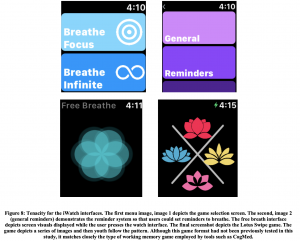
6.2. Participants
We recruited 35 participants across three events in two states through teacher networks. Participants were between the ages of 11 and 15 and actively enrolled in school. This convenience sample was selected to round out the target demographic (at risk middle school youth) rather than randomly sample a population [74]. We chose to add a second site located in the Midwest to add geographic diversity and broaden our sample beyond the school with which we partnered in participatory design1. As such, findings suggest improvements in the application but not underlying phenomena in the population.
6.3. Procedure
1 There are reasons to think that mindfulness technologies may be regarded differently in an, immigrant-heavy school Southern California school to the Midwest, which we wanted to explore.
Each participant was given an Apple iWatch and an iPhone as well as an introduction to the software and overview of the study. They were asked to use Tenacity for two weeks as they would do naturally. Whereas previous studies, following the medical model, required use, we wanted to see how youth use Tenacity outside of compulsion or strong financial incentives. At the end of the two weeks, each group met with researchers and returned devices. They were divided into small groups, where they completed a questionnaire and participated in a 1 hour semi-structured focus group interview. This interview explored user behaviors with the device, impressions, and impact using the device. Sample questions included: How often did you use Tenacity? When and where did you use Tenacity? What did you use Tenacity for? What was using Tenacity like? What was difficult to understand? Following these prompts, participants expanded on answers and discussed responses in focus groups.
6.4 Findings
One third of the participants reported using the app at least once per day (12), some even multiple times in a day (9). Other participants expressed using the apps 2-5 times a week (4). These claims matched analyses of log files (see figure 6).
Most (approximately 80%, 29) of participants reported using the app after school hours or other free time, while a few participants used Tenacity before school to wake up (2) or during school (3). Specifically they reported using it while they were in transit (9), idle (10) or bored (18). Other reported moments of use were after exercising (3), before bed (7) and while doing homework (4). Only 3 participants reported using the app in school, two specifically mentioning lunch hours. 5 reported purposely avoided using it in school completely.
One reason for not wearing it to school was being afraid that something would happen to the watch. This was reflected in reports such as “I think I wore it after school only, because … I just felt kind of weird about bringing a special device to school.” Another reason was school and teacher policy. “Yeah, mine made noise whenever it would disconnect from the iPhone, so right in the middle of class it made a really loud noise. And I was so scared, because Apple watches are kind of banned in my school. You can wear them, but you can’t be on them and you can’t let them make noise.”
Almost (16) 45% of participants reported using Tenacity to calm down. For example, one participant stated, “I use Breathe… because I had to help my dad outside a lot and I got really [stressed out]. (…) Sometimes I use it like three times a day. Mostly because I get really [mad].” None approached Breathe like they would an exercise application. Although these youth expressed an interest in strengthening their attention, there was resistance to setting out time to do it explicitly.
Only 8 participants reported physically sharing the app with others (5 shared with family members and 3 with friends). Participants did not report meeting each other in person to play with the device. We intentionally seeded Tenacity with cohort groups, thinking we may see emerging competition or cooperation that could become challenges, but such events were relatively rare. On occasions, if one youth saw another with the device nearby, they reported competitions with Lotus, the swiping game, as one youth commented, “When we use Lotus we would be competing to see who can get like the fastest time to swipe”. Face-to-face meetings after school were not common. This type of social interaction was also evidenced in the fact that only about 2 suggested improvements directly promoted social interaction. Social features were outweighed by 33 mentions of improvements suggesting non-social, app-centered features such as customization, design, colors and reward structures.
A subset of youth (centered in the Midwest) critiqued Rhythm Tap sharply. Critiques focused partly on a usability issue caused by lag in the Watch application. Southern California youth also noted this lag, but were either willing to forgive it, or more favorably disposed toward a music application that they co-designed and matched their practices. Youth in the Midwest reported low engagement with Tenacity in general, but some reported improvements in memory and pattern recognition. Youth from Southern California reported more activity and some participants reported specific benefits after the weeks of use, such as improved memory and emotional regulation, although these self-reports.
Positive reports concentrated on the accessibility / convenience of a small device at hand (5), having the Apple watch (2), making others jealous/getting attention (1), in-app programmable settings (1), and good visuals on Breathe (2). Although vibration effects were seen as positive (6), sounds were viewed as undesirable (8) and were often turned off.
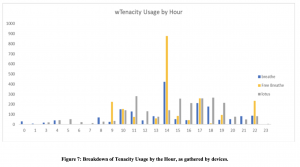
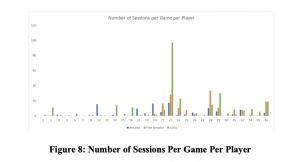
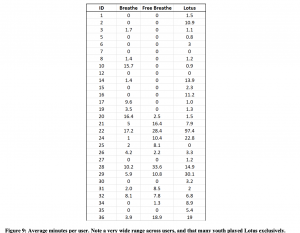
7 REDESIGN RESULTS
Youth responded positively to the redesigned wearable version of Tenacity (including its use case scenario).
Differences in geography, time frame, measurement instruments, and use case make clean comparisons difficult, but comments toward the watch were generally positive (whereas responses to the iPad were not). A subset of participants particularly valued the application and used it regularly. Whereas designers of the original Tenacity iPad application concluded that a breath counting application for the iPad would unlikely reach this target audience, we see evidence for this application appealing to a subset of the audience, particularly those interested in self-regulation.
The primary interest was in using Tenacity to relax and calm down. Youth reported that Tenacity Breathe was useful for relaxing and focusing attention prior to homework. They also reported (and data confirms) it being used in the mornings, between classes, and before sleep. Analytics gathered from the watch confirm this pattern, as the 2pm hour (after school ends) was by far the most popular time, with another time spike in the late evening, presumably before bed.
Being able to organically train SR is of high priority to these youth. Youth were interested in training SR in the process of and service to other activities, but less interested in adding SR training as another separate activity. Youth are already familiar with many digital experiences that offer engaging and fulfilling interactions, some of which are probably training SR. Apolonia best represented the youth disposition by saying, “You can’t tell it’s a game made for something, it’s a game made for fun. I don’t have to play this game to practice my focusing skills.” Designers of SR software should be aware that this awareness of the product space (and potentially the benefits of gaming) may lead to indigenous critiques in which youth question why they are given separate tools for their developing SR, on top of their already busy lives.
Youth demonstrated some interest in collaborative play. Youth reported occasionally racing during Lotus Tap or handing off devices to friends. There was not, however, a strong desire to complete joint achievements; in post interviews youth were reticent to engage in collaborative play with Tenacity Breathe. Many data points (from comments made during design, to the popularity of social media apps) caution against overgeneralizing from this case. There could be implementations that leverage youth interests in social interaction. At the same time, for this audience, breath counting was a private activity.
Youth expressed concerns for ensuring their personal information is kept private. Using Breathe was a distinctly private act for most of these youth. Privacy was mentioned in interviews as a concern and as an obstacle to collaborative play. This suggests a need for a system in which players can selectively share in their play behaviors, yet keep control on what information others can access.
Youth activity was distributed across different mini-games and functions, suggesting that choice may be a key variable in increasing satisfaction with mindfulness apps (which would be consistent with motivation and games generally [see 57a]. The original Tenacity application included afford choices in levels, but the core mechanics and interactions were static. This iteration gave choices across games, which may have led to the increased interest. Crucially, youth complied with this study roughly as much as youth in earlier studies in which participation was compelled (previous studies reported cases of youth “clicking through” breaths), so that it may be optimal for design researchers to encourage optional play modes.
The disruptive qualities of Tenacity Breathe were of a concern to students; some elected to not bring the device to school, and others expressed concerns about the sound. Tenacity was designed to be relatively unobtrusive, but it was still relatively obtrusive in conversations to begin the game, make the requisite taps, and close the game. Game modes may benefit by being as unobtrusive as possible.
Youth were interested in Lotus compared to other applications, as evidenced by its relatively high usage. Some, in fact, used Lotus exclusively. We see strong evidence for the appeal of such brain games deployed on the iWatch.
8 DISCUSSION
Increasing Engagement Through Wearable Technologies. Self-regulation training for youth has followed a medical science paradigm in which a static, uniform intervention is constructed, and then compared to a control to support research findings. These same studies, which have found positive effects, also reported alienating students. Researchers reported wariness with requiring already stressed students to use such an intervention without clear benefits. Youth expressed concerns about stress and anxiety and openness to mindfulness approaches that draw from their own mind-focusing techniques. Youth reported non-trivial amounts of stress (which is echoed in popular media), and are, in the right circumstances, eager to discuss these issues with peers. They found wearable tools designed to enhance these practices were largely appealing.
Future Directions: Biological Markers, Sociobility and Privacy and Wearable Technologies. Youth valued activities to monitor and view information that one is not normally aware of, such as biological markers or how they allocated time. Youth also advocated for competing among friends towards targeted behaviors. We observed some evidence for ad hoc cooperative play. Such an experience would help them unpack their activities for reflection and evaluation. Oaten and Cheng illustrate that extended and genuine self-tracking affords reflection and SR development, which we sought, but were unable to achieve through this design [66, 67]. Technology offers this affordance, as youth should have access to convenient self- regulatory experiences. Breath counting remains a good approach for promoting self-regulation, but researchers are increasingly curious about not just using breath counting, but also using other activities that youth value as a context for training SR with mobile technologies. An activity-independent tracking tool may best help youth as they could use the tool in any context that they already have motivation and engagement with.
Sociability in Mindfulness Apps. Youth did not readily form SR focusing communities or sub-groups, similar to what one might see among communities of users of trackers [35]. These devices were introduced to youth in groups, leveraged pre-existing relationships, and distributed to youth as cohorts, but Tenacity Breathe usage was, during this study, relatively private. There were isolated incidents of youth coordinating their breath counting, and a few turned it into a cooperative game, but these were exceptions. Given that Executive Functions are robustly trained within rich socio-cultural activity, finding ways to develop and nurture communities of some sort (SR training, Breath Counting, Meditation) may lead to robust results. An hybridized model of SR development that could combine focused tasks with a gaming metaphor with socio culturally situated practices, so as to engender the deep forms of learning and identity transformation associated with such practices remains the most compelling scenario. Further integration of group achievements or other social mechanics might enhance cooperative play and will be explored.
Scaffolding Youth Performance vs. Training Underlying Skills. For these youth, the primary interest was in using Tenacity to relax and calm down rather than train Mindfulness as an underlying skill. This emphasis on increasing performance rather than necessarily training their faculties suggests a paradox for designers; on the one hand, youth want to increase their attentional faculties, specifically, their capacity to remain calm in the face of social or school stresses. On the other hand, these same social and academic stresses deplete their already taxed attentional resources. Youth want, and are willing to use (to some degree) a relaxation device, but appeared less eager to embrace an application to train those faculties.
As curriculum designers, we found ourselves increasingly uneasy with some core assumptions behind efforts to develop mindfulness tools for youth. On the one hand, some youth are eager to have such tools. Interventions that help them become better connected to their own physical and emotional states, better able to manage them, and experience relief from these stresses make sense. On the other hand, one might ask if we are only creating better Band-Aids for underlying problems. Youth are raised in a hyper-competitive environment in which many are stressed about school performance in order to get into college so as to secure a future in an uncertain economic system. Are our efforts best placed in developing such apps, or in helping create structural changes toward more equitable systems.
9 CONCLUSION
Designers of game-based approaches to breath counting apps for training self-regulation may face two inevitable tensions: 1) Designing attention grabbing game mechanics vs. designing attention cultivating mechanics. Games thrive on grabbing attention and using mechanics to deepen investment. Breath counting and associated mindfulness tasks involve strengthening the mind in response to the inherent challenge of maintaining focus over large periods of time in which the mind wanders. Standard game-based approaches include action feedback loops (interacting with the system, gaining feedback, and responding). Breath counting as a core mechanic almost necessarily prevents designers from employing such attention- grabbing loops within the technology. Breath counting, or any sort of mindfulness practice is difficult to remediate as game play dynamics, as the action-feedback loops involved place focus on the device rather than one’s own attention. Designers instead may be better poised to use mechanics to cultivate attention – to improve users’ ability to regulate attention — in the practice of breath counting, which would suggest employing techniques more akin to gamification (challenges, rewards, social leaderboards). Reframing the activity not as a game but as gamified breath-counting reminds designers of all the problems with trackers more generally, even among those who may have voluntarily spent hundreds of dollars on them; changing practices and establishing new habits is hard, even for those committed to the process [35]. Lotus resembles a more typical game, and not surprisingly, was used most broadly. Similar to debates in brain games more broadly, advocates of brain-based approaches to cognition must nevertheless grapple with the fact that youth already play games and games could already be training youth attention and memory [58, 69, 73, 76]. Such conundrums remind us that attention is deeply entwined with motivation; the issue we often have is not that youth cannot pay attention, but rather, their attention is grabbed by distractions in less engaging activities (or that they are not attending to those things adults would like them to).
Second, a tension emerged between Tenacity as a relaxation and meditation tool vs. Tenacity as a brain training tool. Presenting tenacity as a relaxation tool suggests that it is a tool for filling one’s attentional energy and reserves, akin to unwinding after school or clearing one’s mind before homework. Such a model suggests that breathing is a relatively easy task untaxing to attentional reserves. Regarding Tenacity as a mental training tool suggests that it is hard work, something that one needs to focus on and “save mental energy” for. There is theoretical overlap between these two; plenty of people exercise physically or mentally to clear the mind. However, these respondents were somewhat taken aback by how much work Tenacity was, and how mentally draining it was to practice regularly. We attempted to resolve this tension by providing two modes (Breathe and Infinite), each of which corresponded to a particular mode. If both modes are the most desirable approach, then how to present and support both is a design challenge. In future iterations, we intend to use gamification techniques to support both approaches as a part of maintaining a healthy mind. We saw, however, evidence for youth interest in playing “brain games” such as Lotus, which includes such game feedback loops.
Finally, a tension reveals one around agency and choice: Requiring sustained participation in breath-counting (or mindfulness) practices to produce outcomes (consistent with a medical model of research and implementation) vs. Encouraging breath-counting (and mindfulness) as a healthy practice and respond to stress. As researchers studying the impact of breath-counting practices through a wearable device, we struggled with a desire to require 20-30 minutes per day from participants to not only achieve results, but help participants themselves experience some of the benefits of mindfulness techniques. At the same time, requiring an additional activity of these youth, on top of everything else they struggle with (homework, extra-curriculars, social lives), felt ethically questionable. Of course, requiring regular activity with likely benefits over a brief period for a few weeks is hardly immoral. But as curriculum designers, we found ourselves increasingly uneasy with some assumptions behind efforts to develop mindfulness tools for youth. On the one hand, some youth are eager to have such tools. Interventions that help them be better connected to their own physical and emotional states, better equipped to manage these stresses, and help them find relief from these stresses make sense. On the other hand, one might ask if we are only creating better Band-Aids for underlying problems. Youth are raised in a hypercompetitive environment in which many are stressed about school performance in order to get into college so as to secure a future in an uncertain economic system. Are our efforts best placed in developing such apps, or in helping create structural changes toward more equitable systems?
We note that the very moments societies are becoming more socially-stratified, harshly competitive, and organized around “winner take all” structures, established institutions turn to individually psychologized paradigms such as grit and tenacity, rather than the social structures that contribute to them [40]. It may be that breath counting and mindfulness training are best presented within both the context of stress reduction and executive functioning, but also a consideration of the social conditions that produce them. If we adopt an activity theory model to understand youth practices, we might predict that these tensions will be resolved by mindfulness tools being used in service of individual achievement and possibly sorting [5]. For this reason, in our own work, we gravitate toward participatory design approaches that seek to empower youth in identifying their emotional states and being active regulators of their own attention. For these reasons, in future iterations of Tenacity, we continue to employ gamified metaphors to build youth self-regulation, position Tenacity as a relaxation, stress-relief tool, and seek to support them in achieving their own goals as opposed to doing researcher-derived tasks and schedules. We are most interested in creating authentic, youth-driven learning experiences in which they interrogate and manage their attention, which may also require working with populations already interested in such activities, rather than studies that randomly sample from a population of users. This approach would drive research away from objectivists models that seek to uncover the working of the brain generally, but would better account for the role of human intentions in self-regulation, arguably an important consideration.
AKNOWLEDGEMENTS
The author would like to acknowledge support from the National Science Foundation Grant EXP: #1828801. In addition, the authors would like to thank Daniel Epstein for a review of an earlier draft of this paper. Finally, we would like to thank Richard Poon, Caleb Chu, Jackson Greaves, and Zachary Cloutier for their work developing Tenacity.